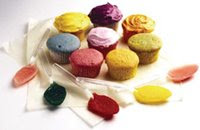 Potassium Bromate
Potassium Bromate: Potassium bromate (KBrO
3), is a bromate of potassium and takes the form of white crystals or powder.
It is typically used as a flour improver (E number E924), strengthening the dough and allowing higher rising. It is an oxidizing agent, and under the right conditions, will be completely used up in the baking bread. However, if too much is added, or if the bread is not cooked long enough or not at a high enough temperature, then a residual amount will remain, which may be harmful if consumed. Potassium bromate might also be used in the production of malt barley where the United States FDA has prescribed certain conditions where it may be used safely, which includes labeling standards for the finished malt barley product. It is a very powerful oxidizer (E°= 1.5 volts comparable to potassium permanganate). Bromate is considered a category 2B (possibly carcinogenic to humans) carcinogen by the International Agency for Research on Cancer (IARC).
Potassium bromate has been banned from use in food products in Europe, as well as the United Kingdom in 1990, and Canada in 1994, and most other countries. It was banned in Sri Lanka in 2001 and China in 2005. It is also banned in Nigeria, Brazil and Peru.
In the United States it has not been banned. The FDA sanctioned the use of bromate before the Delaney clause of the Food, Drug, and Cosmetic Act went into effect in 1958 — which bans carcinogenic substances — so that it is more difficult for it to now be banned. Instead, since 1991 the FDA has urged bakers to voluntarily stop using it. In California a warning label is required when bromated flour is used.
 β-lactamase
β-lactamase: β-lactamases are enzymes (EC 3.5.2.6) produced by some bacteria and are responsible for their resistance to beta-lactam antibiotics like penicillins, cephalosporins (are relatively resistant to beta lactmase), cephamycins, and carbapenems (ertapenem). These antibiotics have a common element in their molecular structure: a four-atom ring known as a beta-lactam. The lactamase enzyme breaks that ring open, deactivating the molecule's antibacterial properties.
β-lactam antibiotics are typically used to treat a broad spectrum of gram-positive and gram-negative bacteria. Beta-lactamases produced by gram-positive organisms are usually secreted.
β-lactamase may be clinically beneficial when orally administered to preserve the natural intestinal flora during the parenteral administration of antibiotics. "This could provide protection against a broad range of nosocomial pathogens," per Dr. Usha Stiefel at the 47th annual Interscience Conference of Antimicrobial Agents and Chemotherapy.
 Dimethyl Fumarate
Dimethyl Fumarate: Dimethyl fumarate is an ester and an α,β-unsaturated electrophilic compound, undergoing reactions typical to them. It is also a diene acceptor in the ordinary Diels-Alder reaction, where the reactivity of its vinylidenic bond is enchanced by the two electron-withdrawing ester groups. Due to its geometry, the Diels-Alder product has a trans configuration.
Dimethyl fumarate is used to treat psoriasis. It is a lipophilic, highly mobile molecule in human tissue. However, as an α,β-unsaturated ester, dimethyl fumarate reacts rapidly with the detoxifying agent glutathione by Michael addition. When administered orally, it does not survive long enough to be absorbed into blood.
Another use for dimethyl fumarate is mold inhibition.
Tests in mouse models have been conducted with the aim of using it as part of a specific cancer treatment.
Dimethyl fumarate has been found to be an allergic sensitizer at very low concentrations, producing extensive, pronounced eczema that is difficult to treat. Concentrations as low as 1 ppm may produce allergic reactions. There are only a handful of equally potent sensitizers.
The extreme sensitizing risk was brought to public attention by the "poison chair" incident, where Chinese manufacturer Linkwise produced two-seater sofas with dimethyl fumarate sachets inside to inhibit mould while they were in storage or transport. In Finland where the chairs were sold from 2006-2007, sixty users were given serious rashes. The cause was identified as dimethyl fumarate -induced allergic reaction by Tapio Rantanen, M.D. from Finland, and his original article became the cover story in the July issue of British Journal of Dermatology. In the United Kingdom, sofas sold by Argos, Land of Leather and Walmsley Furnishing containing the chemical caused over a hundred injuries. Argos withdrew the sofas from stores and contacted buyers to collect those that had been sold — with Land of Leather withdrawing the sofas without notifying buyers and Walmsley saying they had removed the satchets from sofas they sold after the danger came to light. Complaints have been made that dates on the sofas were altered and sofas containing the satchets sold. Land of Leather and Walmsley are facing a ₤10 million class action suit over their reaction to the incident, joining the manufacturer in denying the sofas are connected to their customers injuries. The danger came to public attention when the BBC Watchdog program alerted consumers to the sofas.
Originally Posted:
About Additive
 Citrus skin and core are nutritious, and could be used be good feed additives.
Citrus skin and core are nutritious, and could be used be good feed additives.

























